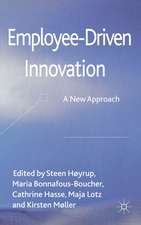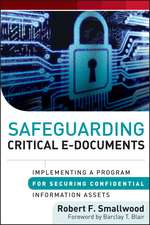Fuzzy and Neuro-Fuzzy Intelligent Systems: Studies in Fuzziness and Soft Computing, cartea 47
Autor Ernest Czogala, Jacek Leskien Limba Engleză Paperback – 2 aug 2012
Din seria Studies in Fuzziness and Soft Computing
- 20%
 Preț: 999.85 lei
Preț: 999.85 lei - 20%
 Preț: 653.06 lei
Preț: 653.06 lei - 20%
 Preț: 872.98 lei
Preț: 872.98 lei - 20%
 Preț: 930.57 lei
Preț: 930.57 lei - 20%
 Preț: 1051.00 lei
Preț: 1051.00 lei - 20%
 Preț: 992.44 lei
Preț: 992.44 lei - 20%
 Preț: 655.85 lei
Preț: 655.85 lei - 20%
 Preț: 1001.86 lei
Preț: 1001.86 lei - 18%
 Preț: 954.14 lei
Preț: 954.14 lei - 20%
 Preț: 330.10 lei
Preț: 330.10 lei - 20%
 Preț: 333.04 lei
Preț: 333.04 lei - 20%
 Preț: 997.56 lei
Preț: 997.56 lei -
 Preț: 391.61 lei
Preț: 391.61 lei - 20%
 Preț: 647.79 lei
Preț: 647.79 lei - 20%
 Preț: 986.01 lei
Preț: 986.01 lei - 18%
 Preț: 958.56 lei
Preț: 958.56 lei - 20%
 Preț: 996.40 lei
Preț: 996.40 lei - 20%
 Preț: 999.35 lei
Preț: 999.35 lei - 15%
 Preț: 646.43 lei
Preț: 646.43 lei - 20%
 Preț: 651.57 lei
Preț: 651.57 lei - 20%
 Preț: 997.89 lei
Preț: 997.89 lei - 15%
 Preț: 641.03 lei
Preț: 641.03 lei - 20%
 Preț: 1009.74 lei
Preț: 1009.74 lei - 20%
 Preț: 992.62 lei
Preț: 992.62 lei -
 Preț: 388.72 lei
Preț: 388.72 lei - 18%
 Preț: 1223.43 lei
Preț: 1223.43 lei - 20%
 Preț: 651.42 lei
Preț: 651.42 lei - 18%
 Preț: 951.59 lei
Preț: 951.59 lei - 18%
 Preț: 948.61 lei
Preț: 948.61 lei
Preț: 328.27 lei
Preț vechi: 410.34 lei
-20% Nou
Puncte Express: 492
Preț estimativ în valută:
62.82€ • 67.17$ • 52.37£
62.82€ • 67.17$ • 52.37£
Carte tipărită la comandă
Livrare economică 18 aprilie-02 mai
Preluare comenzi: 021 569.72.76
Specificații
ISBN-13: 9783662003893
ISBN-10: 3662003899
Pagini: 212
Ilustrații: XVI, 195 p. 72 illus.
Dimensiuni: 155 x 235 x 11 mm
Greutate: 0.3 kg
Ediția:Softcover reprint of the original 1st ed. 2000
Editura: Physica-Verlag HD
Colecția Physica
Seria Studies in Fuzziness and Soft Computing
Locul publicării:Heidelberg, Germany
ISBN-10: 3662003899
Pagini: 212
Ilustrații: XVI, 195 p. 72 illus.
Dimensiuni: 155 x 235 x 11 mm
Greutate: 0.3 kg
Ediția:Softcover reprint of the original 1st ed. 2000
Editura: Physica-Verlag HD
Colecția Physica
Seria Studies in Fuzziness and Soft Computing
Locul publicării:Heidelberg, Germany
Public țintă
ResearchCuprins
1 Classical sets and fuzzy sets Basic definitions and terminology.- 1.1 Classical sets.- 1.2 Fuzzy sets.- 1.3 Operations on fuzzy sets.- 1.4 Classification of t-norms and t-conorms.- 1.5 De Morgan triple and other properties of t- and s-norms.- 1.6 Parameterized t-, s-norms and negations.- 1.7 Fuzzy relations.- 1.8 Cylindrical extension and projection of fuzzy sets.- 1.9 Extension principle.- 1.10 Linguistic variable.- 1.11 Summary.- Bibliographical notes.- 2 Approximate reasoning.- 2.1 Interpretation of fuzzy conditional statement.- 2.2 An approach to axiomatic definition of fuzzy implication.- 2.3 Compositional rule of inference.- 2.4 Fuzzy reasoning.- 2.5 Canonical fuzzy if-then rule.- 2.6 Aggregation operation.- 2.7 Approximate reasoning using a fuzzy rule base.- 2.8 Approximate reasoning with singletons.- 2.9 Fuzzifiers and defuzzifiers.- 2.10 Equivalence of approximate reasoning results using different interpretations of if-then rules.- 2.11 Numerical results.- 2.12 Summary.- Bibliographical notes.- 3 Artificial neural networks.- 3.1 Introduction.- 3.2 Artificial neural networks topologies.- 3.3 Learning in artificial neural networks.- 3.4 Back-propagation learning rule.- 3.5 Modifications of the classic back-propagation method.- 3.6 Optimization methods in neural networks learning.- 3.7 Networks with output linearly depending on parameters.- 3.8 Global optimization methods.- 3.9 Summary.- Bibliographical notes.- 4 Unsupervised learning Clustering methods.- 4.1 Introduction.- 4.2 Self-organizing feature map.- 4.3 Vector quantization and learning vector quantization.- 4.4 An overview of clustering methods.- 4.5 Fuzzy clustering methods.- 4.6 A possibilistic approach to clustering.- 4.7 New generalized weighted conditional fuzzy c-means.- 4.8 Fuzzy learning vector quantization.- 4.9 Cluster validity.- 4.10 Summary.- Bibliographical notes.- 5 Fuzzy systems.- 5.1 Introduction.- 5.2 The Mamdani fuzzy systems.- 5.3 The Takagi-Sugeno-Kang fuzzy systems.- 5.4 Fuzzy systems with parameterized consequents.- 5.5 Summary.- Bibliographical notes.- 6 Neuro-fuzzy systems.- 6.1 Introduction.- 6.2 Artificial neural network based fuzzy inference system.- 6.3 Classifier based on neuro-fuzzy system.- 6.4 ANNBFIS optimization using deterministic annealing.- 6.5 Further investigations of neuro-fuzzy systems.- 6.6 Summary.- Bibliographical notes.- Appendix A: Artificial neural network based fuzzy inference systema MATLAB implementation.- Appendix B: Proof of classifier learning convergence.- 7 Applications of artificial neural network based fuzzy inference system.- 7.1 Introduction.- 7.2 Application to chaotic time series prediction.- 7.3 Application to ECG signal compression.- 7.4 Application to Ripley’s synthetic two-class data classification.- 7.5 Application to the recognition of diabetes in Pima Indians.- 7.6 Application to the iris problem.- 7.7 Application to Monk’s problems.- 7.8 Application to system identification.- 7.9 Application to control.- 7.10 Application to channel equalization.- 7.11 Summary.- Biographical notes.- References.- List of notations and abbreviations.












